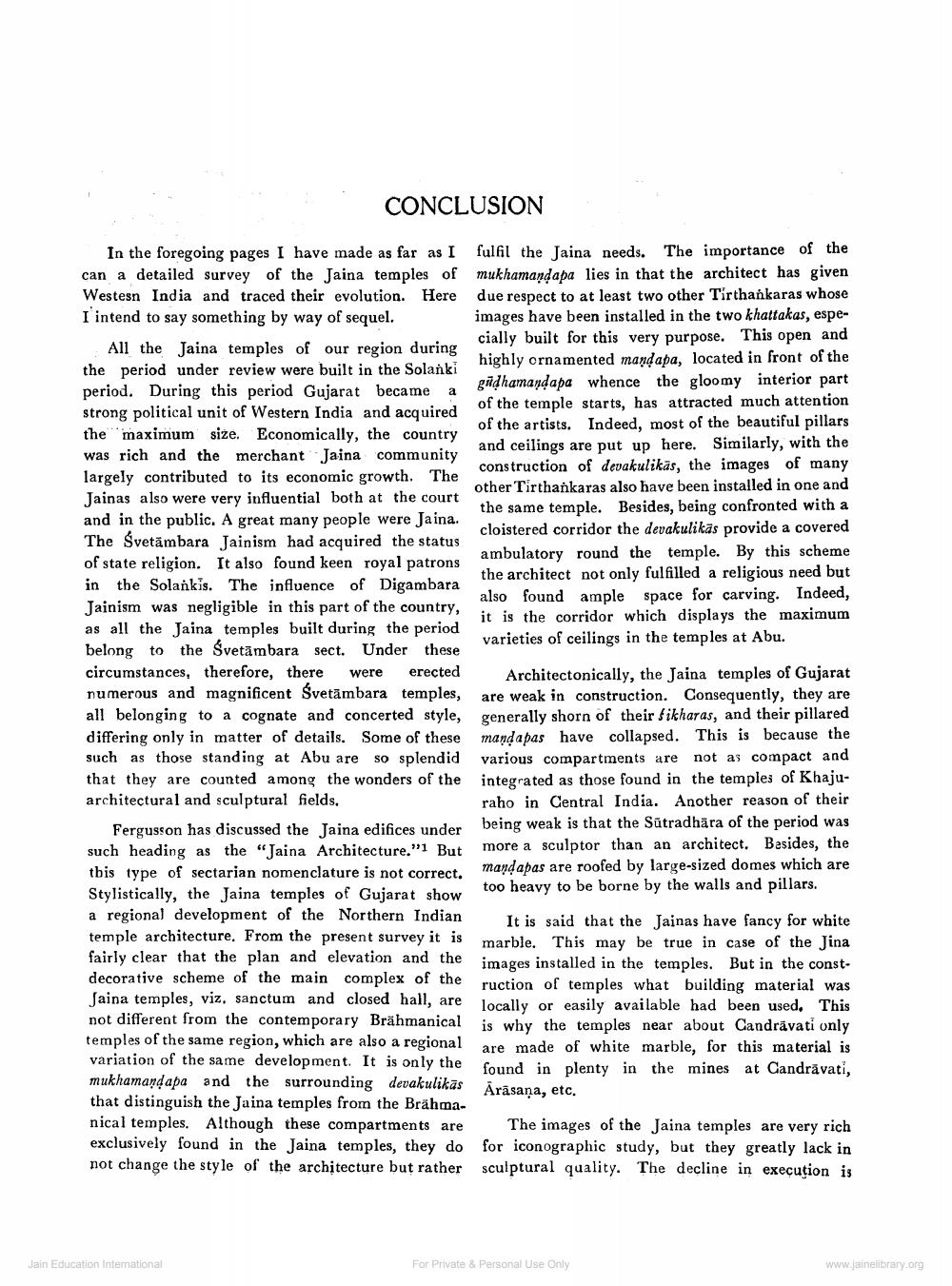________________
CONCLUSION
In the foregoing pages I have made as far as I can a detailed survey of the Jaina temples of Western India and traced their evolution. Here I intend to say something by way of sequel.
All the Jaina temples of our region during the period under review were built in the Solanki period. During this period Gujarat became a strong political unit of Western India and acquired the maximum size. Economically, the country
was rich and the merchant Jaina community largely contributed to its economic growth. The Jainas also were very influential both at the court and in the public. A great many people were Jaina. The Svetambara Jainism had acquired the status of state religion. It also found keen royal patrons
in the Solankis. The influence of Digambara Jainism was negligible in this part of the country, as all the Jaina temples built during the period belong to the Svetämbara sect. Under these circumstances, therefore, there were erected numerous and magnificent Svetambara temples, all belonging to a cognate and concerted style, differing only in matter of details. Some of these such as those standing at Abu are so splendid that they are counted among the wonders of the architectural and sculptural fields.
Fergusson has discussed the Jaina edifices under such heading as the "Jaina Architecture."1 But this type of sectarian nomenclature is not correct. Stylistically, the Jaina temples of Gujarat show a regional development of the Northern Indian temple architecture. From the present survey it is fairly clear that the plan and elevation and the decorative scheme of the main complex of the Jaina temples, viz. sanctum and closed hall, are not different from the contemporary Brahmanical temples of the same region, which are also a regional variation of the same development. It is only the mukhamandapa and the surrounding devakulikās that distinguish the Jaina temples from the Brähmanical temples. Although these compartments are exclusively found in the Jaina temples, they do not change the style of the architecture but rather
Jain Education International
fulfil the Jaina needs. The importance of the mukhamandapa lies in that the architect has given due respect to at least two other Tirthankaras whose images have been installed in the two khattakas, especially built for this very purpose. This open and highly ornamented mandapa, located in front of the gudhamandapa whence the gloomy interior part of the temple starts, has attracted much attention of the artists. Indeed, most of the beautiful pillars
and ceilings are put up here. Similarly, with the construction of devakulikäs, the images of many other Tirthankaras also have been installed in one and the same temple. Besides, being confronted with a cloistered corridor the devakulikäs provide a covered the architect not only fulfilled a religious need but ambulatory round the temple. By this scheme also found ample space for carving. Indeed, it is the corridor which displays the maximum varieties of ceilings in the temples at Abu.
Architectonically, the Jaina temples of Gujarat are weak in construction. Consequently, they are generally shorn of their fikharas, and their pillared mandapas have collapsed. This is because the various compartments are not as compact and integrated as those found in the temples of Khajuraho in Central India. Another reason of their being weak is that the Sutradhara of the period was more a sculptor than an architect. Besides, the mandapas are roofed by large-sized domes which are too heavy to be borne by the walls and pillars.
It is said that the Jainas have fancy for white marble. This may be true in case of the Jina images installed in the temples. But in the construction of temples what building material was locally or easily available had been used. This is why the temples near about Candravati only are made of white marble, for this material is found in plenty in the mines at Candravati, Ārāsaṇa, etc.
The images of the Jaina temples are very rich for iconographic study, but they greatly lack in sculptural quality. The decline in execution is
For Private & Personal Use Only
www.jainelibrary.org




